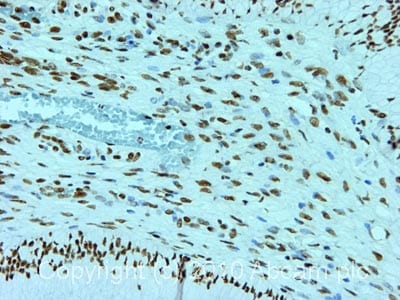Anti-hnRNP H antibody (ab10374)
Key features and details
- Rabbit polyclonal to hnRNP H
- Suitable for: WB, IHC-P, IP, ICC/IF, IHC-Fr
- Reacts with: Mouse, Human
- Isotype: IgG
Overview
-
Product name
Anti-hnRNP H antibody
See all hnRNP H primary antibodies -
Description
Rabbit polyclonal to hnRNP H -
Host species
Rabbit -
Specificity
The antibody was designed against hnRNPH1 and does not recognize hnRNPH3. The epitope recognized by ab10374 maps to a region between residue 400 and the C-terminus (residue 448) of human Heterogeneous Nuclear Ribonucleoprotein H1 using the numbering given in entry NP_005511.1 (GeneID 3187). This product may cross-react with hnRNPH2.
-
Tested applications
Suitable for: WB, IHC-P, IP, ICC/IF, IHC-Frmore details -
Species reactivity
Reacts with: Mouse, Human
Predicted to work with: Rat, Rabbit, Horse, Guinea pig, Dog, Pig, Chimpanzee, Rhesus monkey, Gorilla, Opossum, Orangutan, Elephant
-
Immunogen
Synthetic peptide corresponding to Human hnRNP H aa 400 to the C-terminus (C terminal).
Database link: 3187 -
Positive control
- IP: HeLa whole cell lysate WB: HeLa, HEK-293T, and NIH/3T3 cell lysates.
-
General notes
The Life Science industry has been in the grips of a reproducibility crisis for a number of years. Abcam is leading the way in addressing this with our range of recombinant monoclonal antibodies and knockout edited cell lines for gold-standard validation. Please check that this product meets your needs before purchasing.
If you have any questions, special requirements or concerns, please send us an inquiry and/or contact our Support team ahead of purchase. Recommended alternatives for this product can be found below, along with publications, customer reviews and Q&As
Properties
-
Form
Liquid -
Storage instructions
Shipped at 4°C. Upon delivery aliquot and store at -20°C. Avoid freeze / thaw cycles. -
Storage buffer
pH: 7
Preservative: 0.1% Sodium azide
Constituents: 0.021% PBS, 1.764% Sodium citrate, 1.815% Tris -
 Concentration information loading...
Concentration information loading... -
Purity
Immunogen affinity purified -
Purification notes
Antibodies were affinity purified using the peptide immobilized on solid support. -
Clonality
Polyclonal -
Isotype
IgG -
Research areas
Images
-
Detection of human hnRNP H by immunoprecipitation of whole cell lysate (1.0 mg per IP reaction; 20% of IP loaded) from HeLa cells.
Lane 1: Rabbit polyclonal to hnRNP H (ab10374) at 0.2 µg/mg lysate
Lane 2: Control IgG
ab10374 was used at 1 ug/mL for Western blot.
Detection: Chemiluminescence with an exposure time of 30 seconds.
-
ab10374 detection of human hnRNPH by Western Blot. Samples: Nuclear extract (NE; 40
ab10374 detection of human hnRNPH by Western Blot. Samples: Nuclear extract (NE; 40 µg) from HeLa cells and recombinant human hnRNPH (rH; ~100 ng). Antibody: ab10374 used at the indicated concentrations. Detection: Protein A – HRP with chemiluminescence (20 second exposure after a 20 minute delay to allow signal to decay).µ g) from HeLa cells and recombinant human hnRNPH (rH; ~100 ng). Antibody: ab10374 used at the indicated concentrations. Detection: Protein A – HRP with chemiluminescence (20 second exposure after a 20 minute delay to allow signal to decay). -
 Immunohistochemistry (Formalin/PFA-fixed paraffin-embedded sections) - Anti-hnRNP H antibody (ab10374)Immunohistochemistry (Formalin/PFA-fixed paraffin-embedded sections) analysis of human ovarian carcinoma tissue labelling hnRNP H with ab10374 at 1/1000 (1µg/ml). Detection: DAB.
Immunohistochemistry (Formalin/PFA-fixed paraffin-embedded sections) - Anti-hnRNP H antibody (ab10374)Immunohistochemistry (Formalin/PFA-fixed paraffin-embedded sections) analysis of human ovarian carcinoma tissue labelling hnRNP H with ab10374 at 1/1000 (1µg/ml). Detection: DAB. -
 Immunohistochemistry (Formalin/PFA-fixed paraffin-embedded sections) - Anti-hnRNP H antibody (ab10374)IHC image of ab10374 staining in human normal cervical carcinoma formalin fixed paraffin embedded tissue section, performed on a Leica BondTM system using the standard protocol F. The section was pre-treated using heat mediated antigen retrieval with sodium citrate buffer (pH6, epitope retrieval solution 1) for 20 mins. The section was then incubated with ab10374, 1µg/ml, for 15 mins at room temperature and detected using an HRP conjugated compact polymer system. DAB was used as the chromogen. The section was then counterstained with haematoxylin and mounted with DPX.
Immunohistochemistry (Formalin/PFA-fixed paraffin-embedded sections) - Anti-hnRNP H antibody (ab10374)IHC image of ab10374 staining in human normal cervical carcinoma formalin fixed paraffin embedded tissue section, performed on a Leica BondTM system using the standard protocol F. The section was pre-treated using heat mediated antigen retrieval with sodium citrate buffer (pH6, epitope retrieval solution 1) for 20 mins. The section was then incubated with ab10374, 1µg/ml, for 15 mins at room temperature and detected using an HRP conjugated compact polymer system. DAB was used as the chromogen. The section was then counterstained with haematoxylin and mounted with DPX.
For other IHC staining systems (automated and non-automated) customers should optimize variable parameters such as antigen retrieval conditions, primary antibody concentration and antibody incubation times.











